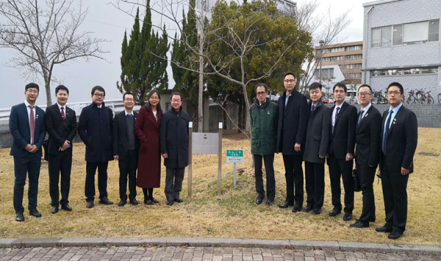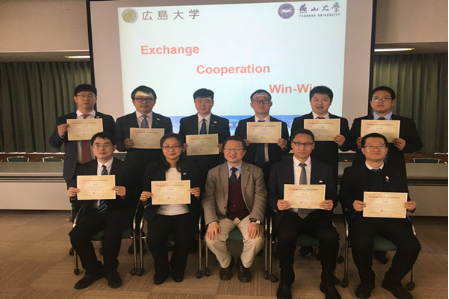[News from the News Center] From March 7 to March 14, ten teachers and students of YSU went to Hiroshima University of Japan for a one-week scientific and technological exchange project between Chinese and Japanese youngsters.This exchange activity was fully funded by the "Sakura Science and Technology Plan" initiated by Japan Science and Technology Agency (JST).
During the project visit, professor Yao Jing from the School of Mechanical Engineering introduced YSU and the School of Mechanical Engineering. Other teachers and students reported their research in respective fields of expertise. Under the meticulous arrangement and accompanied by teachers and students of Hiroshima University, YSU delegation visited the mechanical design system, production system, fluid engineering, material physics engineering, material control engineering of Faculty of Engineering, and the Research Center of Radiology of the Faculty of Science of Hiroshima University.
There were some active interactions with the laboratory professors and students on some research topics. YSU delegation listened to Prof. Xitian’ and Prof. Shenze’s academic reports, they were from the Faculty of Engineering and the Aerospace Center of Hiroshima University respectively. The delegation also visited the Mazda production line and museum, research institutes and factory of Sakai Construction Machinery Co., Ltd, and Tsuneishi Shipbuilding Co., Ltd.

Photo taken for YSU delegation and Professor Xitian of Hiroshima University in front of the friendship tree
The teachers and students of the two universities had forged a profound friendship through one-week academic and cultural interactions insomuch as the two sides had reached an agreement on the content of academic conference between YSU and Hiroshima University in 2018, and the detailed schedule of the “ Sakura Science and Technology Plan” in 2019. After the event, YSU’s ten teachers and students delivered a summary report and shared what they gained from this valuable experience. At the completion ceremony, Prof. Xitian personally granted YSU’s teachers and students the completion certificate of the “Sakura Science and Technology Plan”, which was followed by a friendly discussion with the delegation.

YSU’s teachers and students were granted the completion certificate of the “Sakura Science and Technology Plan”
The “Sakura Science and Technology Plan” is a scientific and technological exchange program which was launched in 2014 and fully funded by Japan’s National Research and Development Corporation,Japan Science and Technology Agency (JST)for Asian young people including Chinese to visit Japan for a short-term study and research. The project was to aim at stimulating young scientists’ passion for the development of science and technology, promoting the scientific and technological exchanges between Asian counties and Japan, which finally contributes to Asian scientific and technological exchanges.
Types of funding projects encompass: (1) Technology-based visit, which is designed to experience Japan’s cutting-edge technologies and expose visitors to Japanese society and culture. According to the project principle, the itinerary in Japan should not exceed 7 days, and the number of visitors should not exceed 10 persons. (2) Joint research type, the two sides will further in-depth research and discussion on specific research topics, or negotiate for new research projects. In principle, the maximum duration of visitor in Japan is 3 weeks. (3) Science and technology training type, which is created to conduct short-term intensive training in some Japan’s superior technology areas. In principle, the itinerary in Japan should not exceed 7days, and the number of visitors should not exceed 15 persons.
This visit was based on our first successful application for the “Sakura Science and Technology Plan”. In 2018, YSU will continue to apply for this project and send a scientific research team to Japan for academic exchange in order to enhance the in-depth cooperation in science and technology between YSU and Japanese scientific research institutions insomuch as to improve our capability of internationalization in education.
[Translated by Liu Ruo]